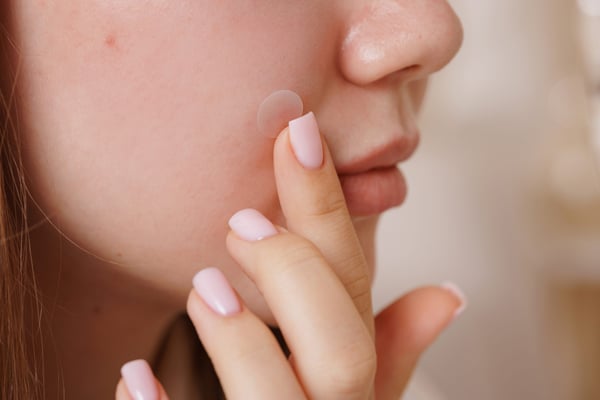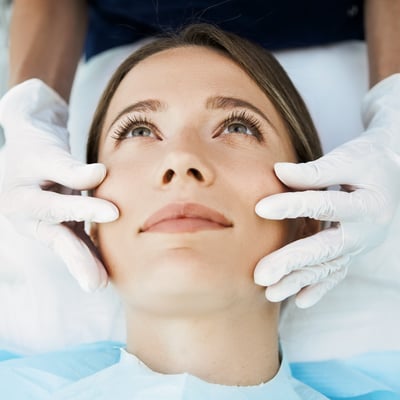
Wouldn’t it be nice to slap a cute little sticker on an ugly pimple and–tada–the pimple is gone when you peel it off? Several products can work that kind of magic, or at least reduce the size and redness of the blemish.
But do acne patches work for everyone? Not in severe cases, and not for some skin conditions. We’ll tell you why you should examine the ingredients before spending money on acne patches, and when you’re better off seeing a dermatologist for help.
How do acne patches work?
A pimple patch is an adhesive protective barrier (like a sticker) that fits over a pimple. Patches can be clear or flesh-colored, which are great for camouflaging unsightly zits while they’re being treated, and they prevent people from being able to pick at their pimples, which can make the blemish worse and lead to scarring. Pimple patches can be worn during the day for a few hours or overnight, and their effectiveness depends on the ingredients they’re made with. You’ll find one or several of the following ingredients listed on the box:
Hydrocolloid. Most pimple patches (such as Mighty Patch™) contain this chemical, which helps absorb moisture, including excess oil and pus. For pimples on the surface, hydrocolloid patches can help flatten and reduce their size. But patches made with hydrocolloid alone are not powerful enough to treat deeper, cystic acne.
Salicylic acid. Often found in facial washes and acne spot treatments, this medication works by dissolving dead skin cells, oil, and other debris that block pores. It’s also effective at reducing the amount of sebum that oil glands produce, which prevents new zits from popping up. Pimple patches containing salicylic acid (like the ones made by Differin) can help make zits smaller faster, but they aren’t likely to draw out stubborn blackheads, and their oil-reducing nature can cause dryness and irritation for sensitive skin. However, some salicylic acid patches also contain hyaluronic acid to keep skin hydrated.
Tea tree oil. This essential oil has antiseptic and antimicrobial properties to kill bacteria that cause pimples, and anti-inflammatory properties to reduce the pimple’s size. Some people are allergic to tea tree oil, even though it’s all-natural.
Micro darts. For deeper blemishes, pimple patches with microcrystals aim to deliver a similar concept as microneedling. Tiny “darts” on the stickers penetrate the top layer of skin and infuse acne-fighting medications like salicylic acid into the skin. While micro-dart patches could work well for mild acne, using them could increase irritation and cause inflammation if used on severe acne or cystic breakouts.
Do dermatologists recommend pimple patches?
For occasional breakouts that are close to the skin’s surface (the ones where you can see the pus just underneath the skin, or that have whiteheads), pimple patches can work well. In a 2023 study published in the American Academy of Dermatology, 41 people who each had at least two inflammatory lesions, with one capable of being extracted (popped), were randomly separated into those who simply used a gentle face wash and those who used a gentle face wash along with hydrocolloid patches. Participants who used the patches experienced a noticeable reduction in size, texture, and redness of closed and popped pimples, and significant improvements in the wound appearance of popped pimples.
However, pimple patches are not the best solution for everyone, such as those with:
Persistent acne
Even if acne patches get rid of your zits, they don’t keep them from coming back. Persistent breakouts could be due to your skin care routine, medications, hormones, your diet, or stress. Talking to a dermatologist about lifestyle changes or skin care recommendations could offer a more permanent solution for achieving clear skin.
Cystic acne
Cystic acne forms deep underneath the skin and is characterized by large, painful, inflamed cysts. People with this type of stubborn acne produce too much oil, have a genetic predisposition in the family), or have excessive bacteria in their pores. Covering zits with a patch could actually cause more harm than good, because it can trap bacteria and moisture in and cause other lesions to pop up.
Sensitive skin
For some people, the ingredients used in acne patches can irritate the skin or make acne worse. If you’ve ever used a facial wash with salicylic acid and noticed dryness or peeling, you should stick to the patches that only have hydrocolloid. The same thing goes for tea tree oil; if you’re allergic or sensitive to it, it can cause redness, dryness, or peeling.
If your skin is verysensitive, even the adhesives used in pimple patches can cause irritation like itching, burning, and redness. Acrylates are a type of polymer used to make the patches stick to the skin, and some people are allergic to them.
What other treatments can I try for acne?
Do acne patches work? The answer is yes, but not for everyone, and they shouldn’t be the only treatment you use. The best way to prevent acne is with a balanced, comprehensive skincare routine. A gentle cleanser, toner, moisturizer, and sunscreen are usually a great place to start. And if you deal with acne regularly, it may be time to incorporate retinoids, salicylic acid, and benzoyl peroxide into your routine. Severe acne is best addressed by a dermatologist, who may prescribe medications such as:
Tetracycline. This is an antibiotic that stops bacterial growth that causes acne. It also helps to reduce redness and swelling associated with zits.
Isotretinoin. It’s a powerful retinoid that works by reducing the production of the skin’s natural oil (sebum), but it’s reserved for only severe cases of acne since it can lead to birth defects in pregnant women and can be dangerous for people with certain health problems.
Hormonal therapies. Sometimes an overproduction of sebum (oil) is due to excessive androgens (hormones) in the body. Taking birth control pills or androgen blockers can reduce oil production to clear up acne.
When topical treatments and oral medications don’t work, non-invasive laser therapy might. For instance, Cutera Laser Genesis uses controlled heat to kill acne-causing bacteria under the surface of the skin. It also penetrates overactive sebaceous glands to help regulate oil production, and stimulates collagen production. Besides reduced acne, patients notice smaller pores, smoother skin, and fewer fine lines.
Still not sure if you should use pimple patches? Ask a dermatologist at Forefront.
When it comes to the health of your skin, it never hurts to ask an expert for help. A Forefront dermatologist will examine your skin and discuss what the underlying causes of your acne may be. Then, he or she can offer solutions for achieving clear skin for years to come. Contact a Forefront office near you now.





